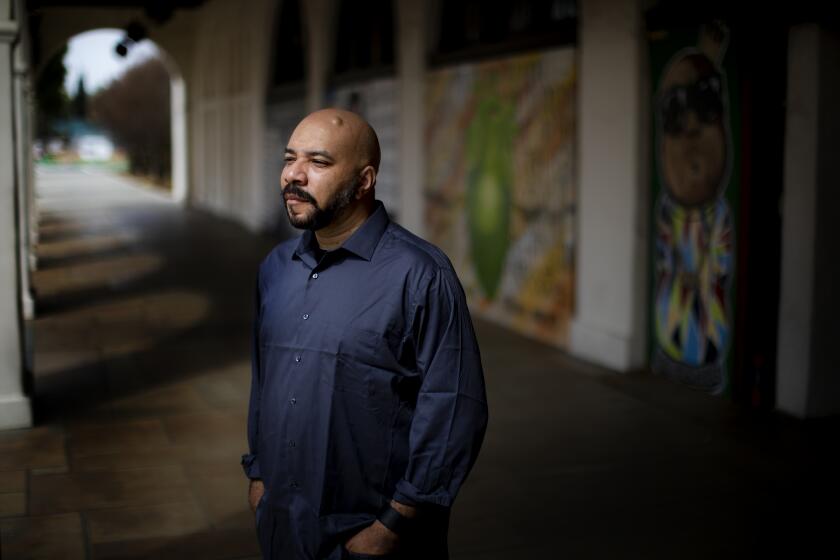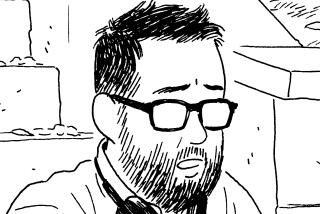How an L.A. animator launched a graphic novel about anti-Asian hate
On the Shelf
Cyclopedia Exotica
By Aminder Dhaliwal
Drawn and Quarterly: 268 pages, $25
If you buy books linked on our site, The Times may earn a commission from Bookshop.org, whose fees support independent bookstores.
“I thought there was something interesting about studying a minority versus being a minority,” Aminder Dhaliwal says. She’s explaining why her second graphic novel, “Cyclopedia Exotica,” begins with a rupture of the fourth wall: a page of information about the Cyclops, “an exotic subspecies of archaic humans,” suddenly interrupted by one of their kind looking up from the page to address the reader directly. “Oh, hi,” she says. “You’re reading about me, I see. Blegh! What a dull way to learn about a minority.”
This particular Cyclops is Etna, one of the characters Dhaliwal follows through a series of short comics that offer an intimate look at how Cyclopes live and work among the two-eyed majority. In a time of persistent hate crimes against Asian Americans, the parallels are clear — and intended, Dhaliwal says. But then, “I had so many people messaging me asking, is this about the trans experience? It was so enlightening to see, we’re all just going through the same things.”
Dhaliwal’s first book, “Woman World,” imagining a man-free planet, was published in 2018. She regularly posts panels from her works in progress on her Instagram account to thousands of followers. When she’s not drawing comics, she works in animation, with credits on shows including “SpongeBob SquarePants” and “Steven Universe.” She spoke with The Times about the power of Instagram, the frustrations of Hollywood and how different mediums helped her break free of comic conventions.
“Cyclopedia Exotica” feels particularly L.A.-inflected. Two of the Cyclopes, Jian and Gray, have a storyline about making and selling art. Then there’s all this discussion about how body image gets manufactured and sold to us. Do you think living here has affected the stories you’re telling?
Because I worked in children’s animation, there were all these rules about what could happen in an episode — and what could a child understand? What will make you lose advertisers’ money? It’s just so frustrating, and it filtered into my comics.
A new generation of Black artists is amending and countering comic books’ racist roots. They join a proud tradition of Black pioneers.
A lot of it too was friends telling me stories of microaggressions, where you come to this big ol’ melting pot and you almost don’t expect it to happen. But you start picking up on the small things, because maybe the big things aren’t happening now. The Jian and Gray story — I’ve felt that. I had so much of my life where people would ask me to come pitch on something. They would always ask for “the Indian version,” and I always felt so unhelpful. I grew up in England, and then I moved to Canada!
It’s a really odd feeling to be brought in and told how great your work is and then to have that slow realization that it might have more to do with the color of your skin or what pronouns you use. Or how many followers you have, because you might be a free way of advertising something.
Speaking of which, you have quite an Instagram following. When did you decide to start posting comics on your account?
I had a pilot which took years to complete and it didn’t get picked up. I felt like I had lost so much time making something hidden behind an NDA, and all I wanted to do was just put out stuff and have people interact with it. In late 2016, I had this urge to make something and I felt lost about how to go about it. So I asked some friends for advice and we ended up having this discussion about how to use the platform the best way. I decided I would start with some quick ideas I had.
[One of those ideas] was “Woman World.” It happened to be close to International Women’s Day, and I was like, oh, that’s cool, I can launch it on that day. I’m thinking I’ll do three weeks of it. It just started taking off faster than I had ever imagined. I got to 100 comics and decided, I’ve got to figure out some publishing — or self-publishing, is what I was thinking.
So much of entertainment and publishing is convincing someone that it’s worth putting money into it because it has an audience. So for me to have the numbers is really liberating. This was the first time in my life where I’m not asking for permission to make things. I’ve just made something out of the want of wanting to make it.
Alison Bechdel talks about her ‘fitness memoir,’ ‘The Secret to Superhuman Strength,’ the first book in 9 years from the pioneering graphic memoirist.
How did you turn the comics from Instagram posts into an actual book?
It was surprisingly hard! I thought I was ahead of the game where I had everything ready to go, and then I would put stuff up on the page, lay it out — and it felt wrong. I realized how much the Instagram slide feature had helped with the timing of a comic. I had to revisit [it] through a panel lens, adding in panels here and there to carve in some time and space before a punchline.
You also added a section at the end where you talk about the characters — where their names come from and your intentions in creating them. Why did that feel important?
When you make slice-of-life comics, there’s only so in-depth you can go, and so much of my work is being aware that someone is stopping on it for five minutes and not really thinking that much more about it. So [the author’s intention section] was my chance to go in there and get to be all intellectual. These comics are called slice of life, but if you have enough slices of life, eventually you have the whole life.
The author of “Gold Diggers,” a novel set in Atlanta’s South Asian community, mourns the security she once felt among strip malls that are now crime scenes.
You’re in the process of pitching both your books for animated adaptations, which is the other field you work in. What does it mean to you to think about your work going full-circle like that?
I sometimes feel like my animation brain stops me from making the best comic choices. For the longest time I thought of the four lines that make up a panel as these limits I could not surpass. And then I remember reading “S— Is Real” by Aisha Franz, and there’s a part in it where the main character gets drunk and slowly the panels get more and more wobbly. It was so beautifully done. [I had] never thought about the panels as this extra element of storytelling.
I’ve tried to push myself more with what I do in a comic, and then I love taking those ideas back to animation and seeing, “How can we play around with the actual film, the digital side of it?” There’s so many ways to tell a story.
Romanoff is a writer and the author of several novels for young adults.
More to Read
Sign up for our Book Club newsletter
Get the latest news, events and more from the Los Angeles Times Book Club, and help us get L.A. reading and talking.
You may occasionally receive promotional content from the Los Angeles Times.







